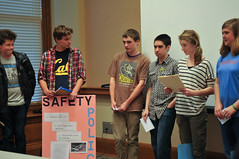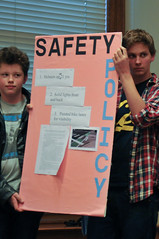In City Hall last night, Portland’s bicycle transportation leaders heard from a group of kids that will likely replace them someday.
Six students from Laurelhurst School in Northeast Portland came to the City’s Bicycle Advisory Committee (BAC) meeting to present a class project devoted to bicycle safety policy.
The students were part of a “Project Citizen” class where they were tasked with fixing a community problem. They chose to focus on bike safety, “since biking is such a huge part of Portland.”
They came up with three policy alternatives for further evaluation: raising the mandatory helmet use age to 21 (it’s currently under 16); to require bike lights on the front and rear (current law requires a front light but only a rear reflector); and to use colored thermoplastic on bike lanes at certain intersections, to “make them much more visible to cyclists and drivers.”
The students then conducted a survey of 125 of their classmates to find out which of the three policies was most important. The survey showed that more visible bike lanes was the winner with 88 percent of respondents rating it 3 or above (on a scale of 1-5) and 49 percent saying it was the most important of the three.
With direction from the survey, the students delved more deeply into the colored bike lane idea. They researched locations “with a history of accidents” or intersections the City has previously identified (and yes, they were told during a Q & A to use the word “crashes” or “collisions” instead).
“Our goal,” wrote the students in a handout passed around to members of the BAC, “is that this will increase the visibility to bikers and drivers so that there will be fewer accidents and fatalities including bikers.”
They also concluded through research that it would only cost $2,500 (including labor and materials) to treat each intersection.
“Our policy is not complicated… It does not require buying more property or tearing up streets… This is very simple and cheap compared to other projects that are going on in the city.”
Yep. Bike safety policy is sometimes that simple.
Congrats to the students for an impressive presentaiton. I have a feeling I might be meeting some of them again a few years down the road.




